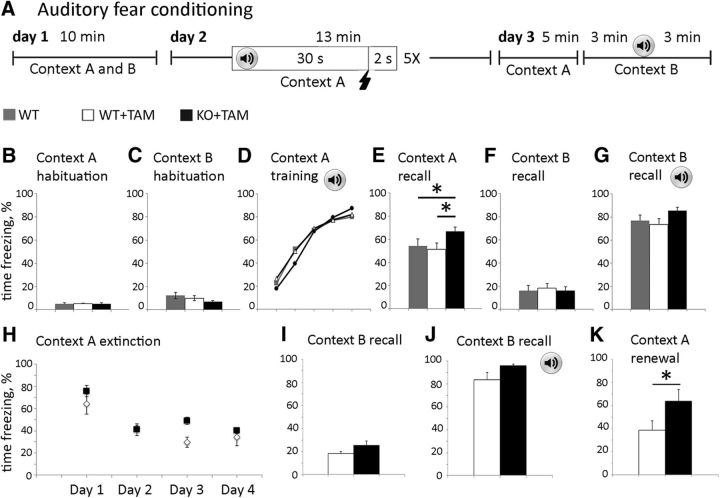Figure 4.
Performance of astro-ephrin-B1 KO mice is improved in contextual fear conditioning test. A, Schematic depiction of fear conditioning test. Mice were habituated to contexts A and B for 10 min on day 1. On day 2 mice were placed in Context A and received 5 random 0.7 mA foot shocks for 2 s after a 30 s tone at 70 Hz, training the mice to associate the tone with the foot shock. On day 3 mice were placed in Context A for 5 min, 1 h later mice were placed in Context B for 6 min and exposed to a 70 dB tone for the last 3 min. B–G, Graphs show the percentage of time that mice freeze during each trial, including Context A habituation (B), Context B habituation (C), Context A training (D), Context A recall (E), Context B without (F), and with tone (G). KO+TAM mice show higher freezing than WT and WT+TAM mice during Context A recall (E). Graphs show mean values and error bars represent SEM (n = 20–21 mice per group, two-way ANOVA followed by Bonferroni multiple-comparison post-test; F(4,146) = 3.601 *p < 0.05). H–K, Graphs show the percentage of time that mice freeze during extinction in Context A (H), Context B recall without tone (I), memory reactivation in Context B with a tone (J), and memory renewal in Context A (K). KO+TAM mice show higher freezing than WT+TAM mice during memory renewal in Context A. Graphs show mean values and error bars represent SEM (n = 5 mice per group, t test; *p < 0.05 t(7) = 2.534).

